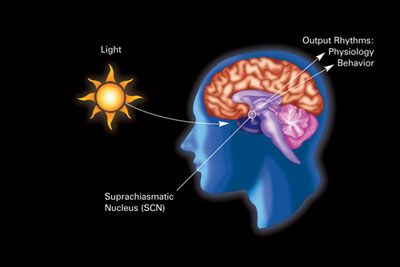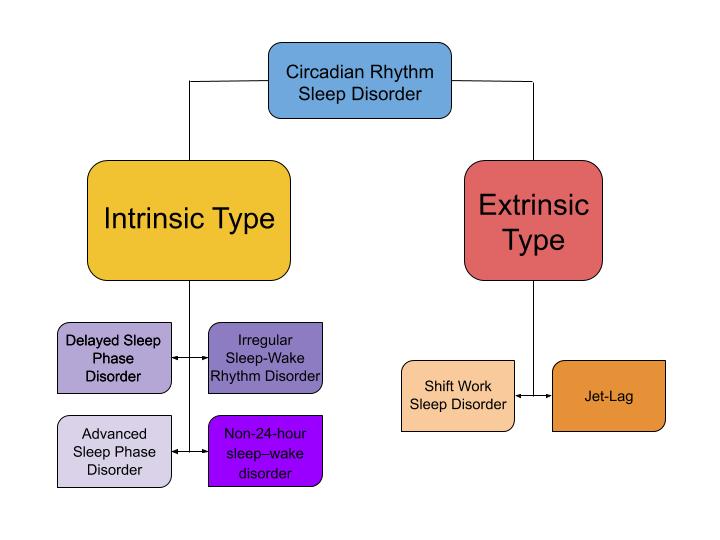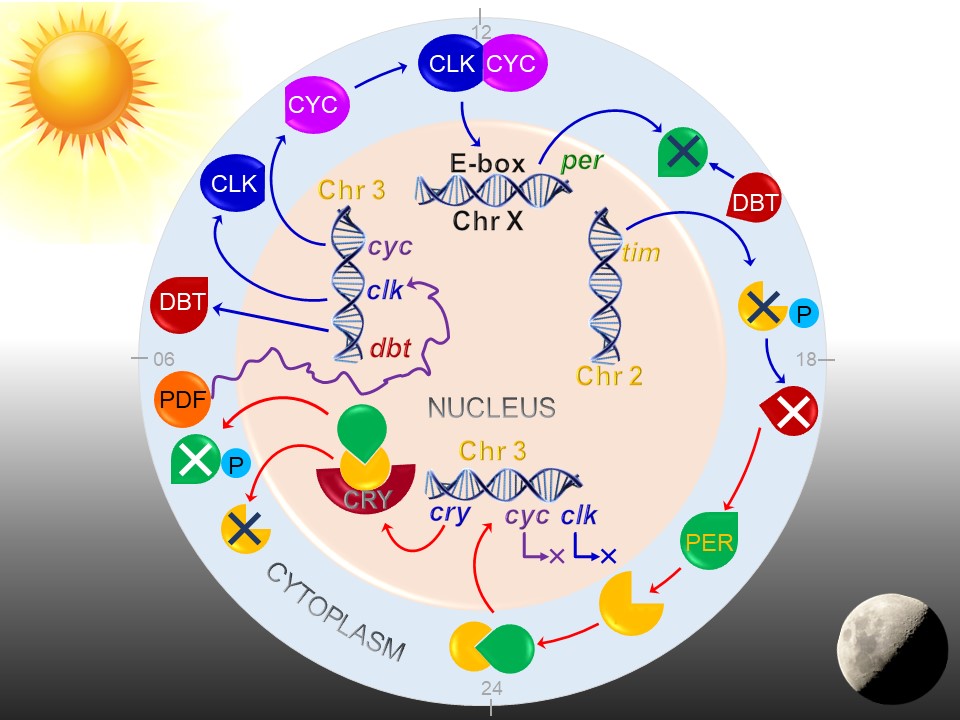|
Irregular Sleep–wake Rhythm
Irregular sleep–wake rhythm (ISWD) is a rare form of circadian rhythm sleep disorder. It is characterized by numerous naps throughout the 24-hour period, no main nighttime sleep episode, and irregularity from day to day. Affected individuals have no pattern of when they are awake or asleep, may have poor quality sleep, and often may be very sleepy while they are awake. The total time asleep per 24 hours is normal for the person's age. The disorder is serious—an invisible disability. It can create social, familial, and work problems, making it hard for a person to maintain relationships and responsibilities, and may make a person home-bound and isolated. Causes ISWD has various causes, including neurological disorders such as dementia (particularly Alzheimer's Disease), brain damage, or intellectual disabilities. It is thought that those affected have a weak circadian clock. The risk for the disorder increases with age, but only due to increased prevalence of co-morbid medical ... [...More Info...] [...Related Items...] OR: [Wikipedia] [Google] [Baidu] |
Circadian Rhythm Sleep Disorder
Circadian rhythm sleep disorders (CRSD), also known as circadian rhythm sleep-wake disorders (CRSWD), are a family of sleep disorders which affect the timing of sleep. CRSDs arise from a persistent pattern of sleep/wake disturbances that can be caused either by dysfunction in one's biological clock system, or by misalignment between one's endogenous oscillator and externally imposed cues. As a result of this mismatch, those affected by circadian rhythm sleep disorders have a tendency to fall asleep at unconventional time points in the day. These occurrences often lead to recurring instances of disturbed rest, where individuals affected by the disorder are unable to go to sleep and awaken at "normal" times for work, school, and other social obligations. Delayed sleep phase disorder, advanced sleep phase disorder, non-24-hour sleep–wake disorder and irregular sleep–wake rhythm disorder represents the four main types of CRSD. Overview Humans, like most living organisms, hav ... [...More Info...] [...Related Items...] OR: [Wikipedia] [Google] [Baidu] |
Vitamin B12
Vitamin B12, also known as cobalamin, is a water-soluble vitamin involved in metabolism. It is one of eight B vitamins. It is required by animals, which use it as a cofactor in DNA synthesis, in both fatty acid and amino acid metabolism. It is important in the normal functioning of the nervous system via its role in the synthesis of myelin, and in the circulatory system in the maturation of red blood cells in the bone marrow. Plants do not need cobalamin and carry out the reactions with enzymes that are not dependent on it. Vitamin B12 is the most chemically complex of all vitamins, and for humans, the only vitamin that must be sourced from animal-derived foods or from supplements. Only some archaea and bacteria can synthesize vitamin B12. Most people in developed countries get enough B12 from the consumption of meat or foods with animal sources. Foods containing vitamin B12 include meat, clams, liver, fish, poultry, eggs, and dairy products. Many breakfast cereals a ... [...More Info...] [...Related Items...] OR: [Wikipedia] [Google] [Baidu] |
Sleep Disorders
A sleep disorder, or somnipathy, is a medical disorder of an individual's sleep patterns. Some sleep disorders are severe enough to interfere with normal physical, mental, social and emotional functioning. Polysomnography and actigraphy are tests commonly ordered for diagnosing sleep disorders. Sleep disorders are broadly classified into dyssomnias, parasomnias, circadian rhythm sleep disorders involving the timing of sleep, and other disorders including ones caused by medical or psychological conditions. When a person struggles to fall asleep and/or stay asleep with no obvious cause, it is referred to as insomnia, the most common sleep disorder. Others include sleep apnea, narcolepsy and hypersomnia (excessive sleepiness at inappropriate times), sleeping sickness (disruption of sleep cycle due to infection), sleepwalking, and night terrors. Sleep disruptions can be caused by various issues, including teeth grinding (bruxism) and night terrors. Management of sleep disturbances ... [...More Info...] [...Related Items...] OR: [Wikipedia] [Google] [Baidu] |
Delayed Sleep Phase Disorder
Delayed sleep phase disorder (DSPD), more often known as delayed sleep phase syndrome and also as delayed sleep–wake phase disorder, is a delaying of a person's circadian rhythm (biological clock) compared to those of societal norms. The disorder affects the timing of biological rhythms including sleep, peak period of alertness, core body temperature, and hormonal cycles. The diagnosis of this disorder is currently a point of contention among specialists of sleep disorders. Many insomnia-related disorders can present significantly differently between patients, and circadian rhythm disorders and melatonin related disorders are not well understood by modern medical science. The orexin system was identified only in 1998, yet it appears intimately implicated in human sleep-wake systems. Evidence for the plasticity of human circadian rhythm cycles has been provided by multiple studies. In one example, several dozen volunteers spent many months underground in a French cave, ... [...More Info...] [...Related Items...] OR: [Wikipedia] [Google] [Baidu] |
Circadian Rhythm
A circadian rhythm (), or circadian cycle, is a natural, internal process that regulates the sleep–wake cycle and repeats roughly every 24 hours. It can refer to any process that originates within an organism (i.e., endogenous) and responds to the environment ( entrained by the environment). These 24-hour rhythms are driven by a circadian clock, and they have been widely observed in animals, plants, fungi and cyanobacteria. The term ''circadian'' comes from the Latin ''circa'', meaning "approximately", and ''dies'', meaning "day". Processes with 24-hour cycles are more generally called diurnal rhythms; diurnal rhythms should not be called circadian rhythms unless they can be confirmed as endogenous, and not environmental. Although circadian rhythms are endogenous, they are adjusted to the local environment by external cues called zeitgebers (German for "time givers"), which include light, temperature and redox cycles. In clinical settings, an abnormal circadian rhythm in h ... [...More Info...] [...Related Items...] OR: [Wikipedia] [Google] [Baidu] |
Chronobiology
Chronobiology is a field of biology that examines timing processes, including periodic (cyclic) phenomena in living organisms, such as their adaptation to solar- and lunar-related rhythms. These cycles are known as biological rhythms. Chronobiology comes from the ancient Greek χρόνος (''chrónos'', meaning "time"), and biology, which pertains to the study, or science, of life. The related terms ''chronomics'' and ''chronome'' have been used in some cases to describe either the molecular mechanisms involved in chronobiological phenomena or the more quantitative aspects of chronobiology, particularly where comparison of cycles between organisms is required. Chronobiological studies include but are not limited to comparative anatomy, physiology, genetics, molecular biology and behavior of organisms related to their biological rhythms. Other aspects include epigenetics, development, reproduction, ecology and evolution. The subject Chronobiology studies variations of the ... [...More Info...] [...Related Items...] OR: [Wikipedia] [Google] [Baidu] |
Advanced Sleep Phase Syndrome
Advanced Sleep Phase Disorder (ASPD), also known as the advanced sleep-phase type (ASPT) of circadian rhythm sleep disorder, is a condition that is characterized by a recurrent pattern of early evening (e.g. 7-9 PM) sleepiness and very early morning awakening (e.g. 2-4 AM). This sleep phase advancement can interfere with daily social and work schedules, and results in shortened sleep duration and excessive daytime sleepiness. The timing of sleep and melatonin levels are regulated by the body's central circadian clock, which is located in the suprachiasmatic nucleus in the hypothalamus. Symptoms Individuals with ASPD report being unable to stay awake until conventional bedtime, falling asleep early in the evening, and being unable to stay asleep until their desired waking time, experiencing early morning insomnia. When someone has advanced sleep phase disorder their melatonin levels and core body temperature cycle hours earlier than an average person. These symptoms must be present ... [...More Info...] [...Related Items...] OR: [Wikipedia] [Google] [Baidu] |
Brigham And Women's Hospital
Brigham and Women's Hospital (BWH) is the second largest teaching hospital of Harvard Medical School and the largest hospital in the Longwood Medical Area in Boston, Massachusetts. Along with Massachusetts General Hospital, it is one of the two founding members of Mass General Brigham, the largest healthcare provider in Massachusetts. Sunil Eappen serves as the hospital's current president. Brigham and Women's Hospital conducts the second largest (behind MGH) hospital-based research program in the world, with an annual research budget of more than $630 million. Pioneering achievements at BWH have included the world's first successful heart valve operation and the world's first solid organ transplant. In the 2020 '' U.S. News & World Report'' hospital rankings, BWH was ranked second in Massachusetts (behind MGH) and twelfth nationally. History Brigham and Women's Hospital was established with the 1980 merger of three Harvard-affiliated hospitals: Peter Bent Brigham Hospita ... [...More Info...] [...Related Items...] OR: [Wikipedia] [Google] [Baidu] |
Harvard Medical School
Harvard Medical School (HMS) is the graduate medical school of Harvard University and is located in the Longwood Medical Area of Boston, Massachusetts. Founded in 1782, HMS is one of the oldest medical schools in the United States and is consistently ranked first for research among medical schools by '' U.S. News & World Report''. Unlike most other leading medical schools, HMS does not operate in conjunction with a single hospital but is directly affiliated with several teaching hospitals in the Boston area. Affiliated teaching hospitals and research institutes include Dana–Farber Cancer Institute, Massachusetts General Hospital, Brigham and Women's Hospital, Beth Israel Deaconess Medical Center, Boston Children's Hospital, McLean Hospital, Cambridge Health Alliance, The Baker Center for Children and Families, and Spaulding Rehabilitation Hospital. History Harvard Medical School was founded on September 19, 1782, after President Joseph Willard presented a report w ... [...More Info...] [...Related Items...] OR: [Wikipedia] [Google] [Baidu] |
Circadian Rhythm Labeled
A circadian rhythm (), or circadian cycle, is a natural, internal process that regulates the sleep–wake cycle and repeats roughly every 24 hours. It can refer to any process that originates within an organism (i.e., endogenous) and responds to the environment ( entrained by the environment). These 24-hour rhythms are driven by a circadian clock, and they have been widely observed in animals, plants, fungi and cyanobacteria. The term ''circadian'' comes from the Latin '' circa'', meaning "approximately", and ''dies'', meaning "day". Processes with 24-hour cycles are more generally called diurnal rhythms; diurnal rhythms should not be called circadian rhythms unless they can be confirmed as endogenous, and not environmental. Although circadian rhythms are endogenous, they are adjusted to the local environment by external cues called zeitgebers (German for "time givers"), which include light, temperature and redox cycles. In clinical settings, an abnormal circadian rhythm in hu ... [...More Info...] [...Related Items...] OR: [Wikipedia] [Google] [Baidu] |
Sedative
A sedative or tranquilliser is a substance that induces sedation by reducing irritability or excitement. They are CNS depressants and interact with brain activity causing its deceleration. Various kinds of sedatives can be distinguished, but the majority of them affect the neurotransmitter gamma-aminobutyric acid (GABA). In spite of the fact that each sedative acts in its own way, most produce relaxing effects by increasing GABA activity. This group is related to hypnotics. The term ''sedative'' describes drugs that serve to calm or relieve anxiety, whereas the term ''hypnotic'' describes drugs whose main purpose is to initiate, sustain, or lengthen sleep. Because these two functions frequently overlap, and because drugs in this class generally produce dose-dependent effects (ranging from anxiolysis to loss of consciousness) they are often referred to collectively as ''sedative-hypnotic'' drugs. Sedatives can be used to produce an overly-calming effect ( alcohol being the ... [...More Info...] [...Related Items...] OR: [Wikipedia] [Google] [Baidu] |
Wakefulness-promoting Agent
Eugeroics (originally "eugrégorique" or "eugregoric"), also known as wakefulness-promoting agents and wakefulness-promoting drugs, are a class of drugs that promote wakefulness and alertness. They are medically indicated for the treatment of certain sleep disorders including excessive daytime sleepiness (EDS) in narcolepsy or obstructive sleep apnea (OSA). Eugeroics are also often prescribed off-label for the treatment of EDS in idiopathic hypersomnia, a rare and often debilitating sleep disorder which currently has no official treatments approved by the Food and Drug Administration (FDA). In contrast to classical psychostimulants, such as methylphenidate and amphetamine, which are also used in the treatment of these disorders, eugeroics typically do not produce euphoria, and, consequently, have a lower addictive potential. Modafinil and armodafinil are each thought to act as selective, weak, atypical dopamine reuptake inhibitors (DRI), whereas adrafinil acts as a prodrug ... [...More Info...] [...Related Items...] OR: [Wikipedia] [Google] [Baidu] |






